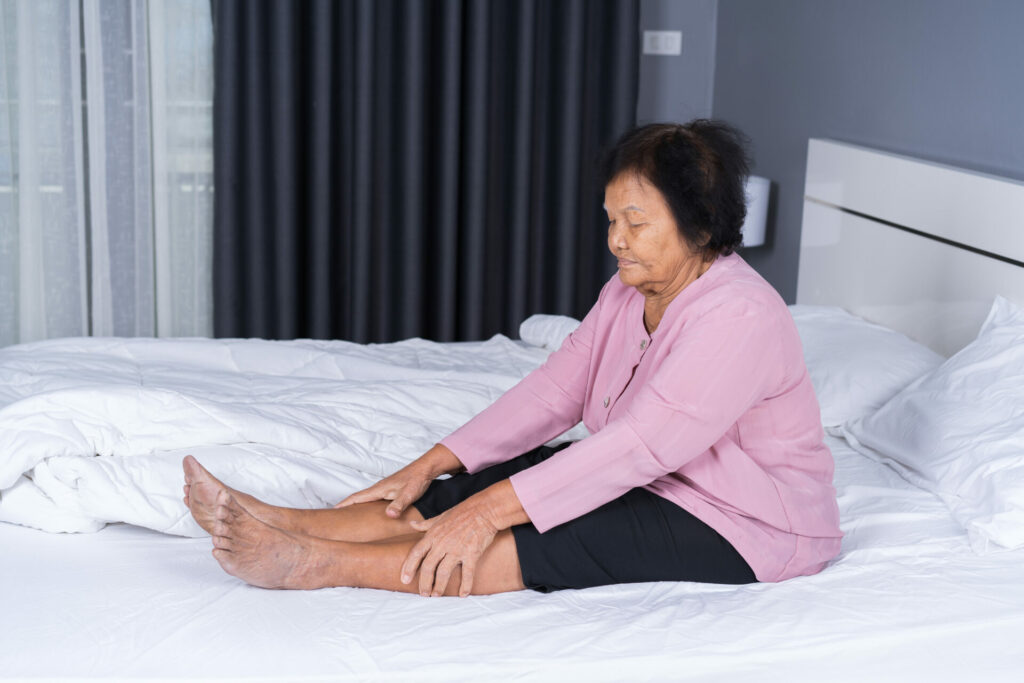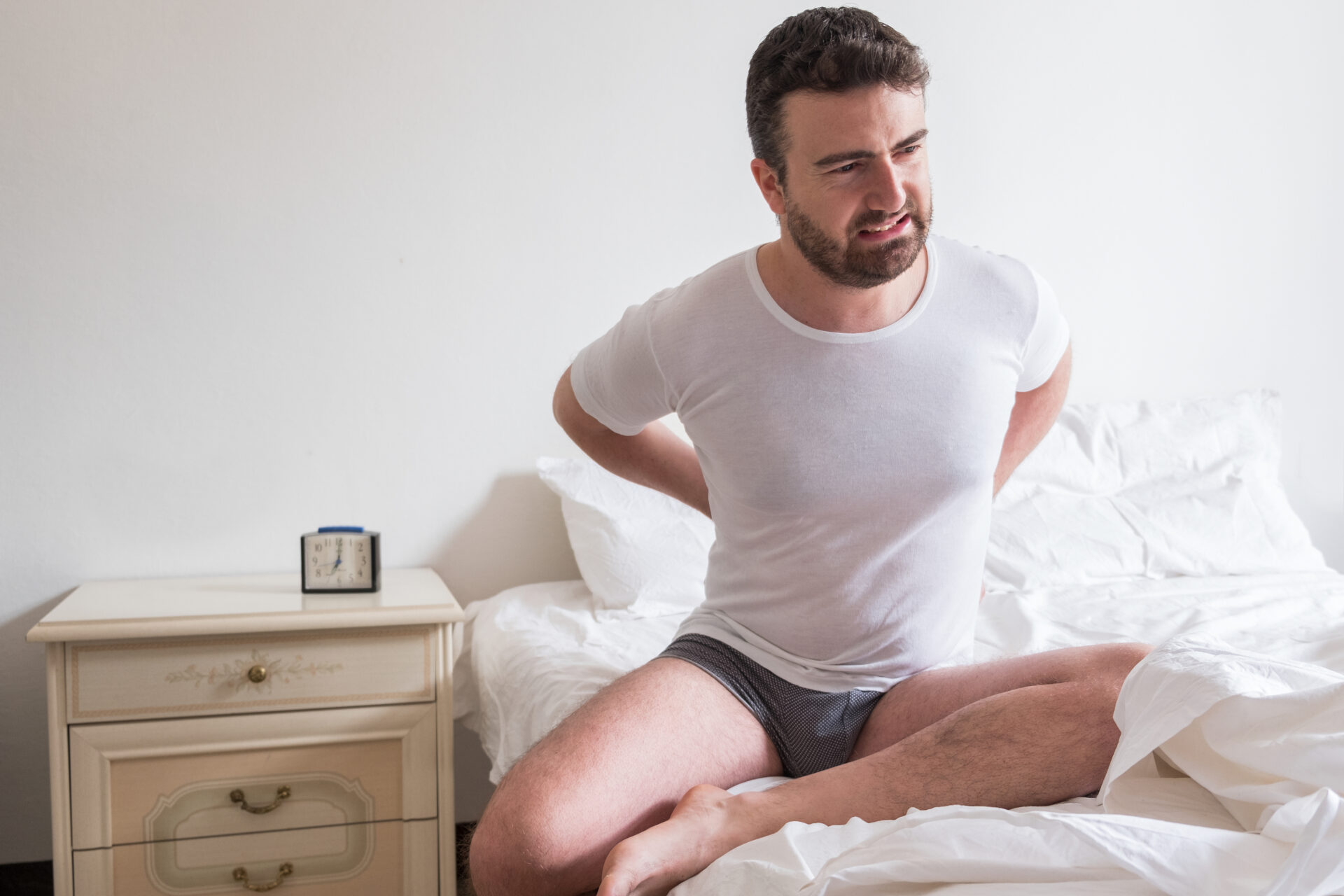For some people, sciatica pain is worse at night when they’re trying to sleep. A lack of proper sleep can affect your mood, quality of life, and even worsen your pain [1].
In this article, we’ll discuss how to relieve sciatica pain in bed, the best sleeping positions and other tips to improve nighttime sciatica pain. We’ll also explore the treatment options available for sciatica at Harley Street Specialist Hospital.
What is sciatica?
Your sciatic nerve runs from your lower back through your buttocks and down each leg. If this nerve is compressed, irritated or inflamed, you may experience sciatica pain. You usually have sciatica on just one side, but more rarely, you can get it on both sides (bilateral sciatica).
Symptoms of sciatica include:
- Aching, burning or shooting pain in your legs, lower back, buttocks or feet
- In some cases, sciatica can cause groin pain
- Weakness in your legs and feet
- Numbness or tingling in your legs, feet or toes
How to relieve sciatica pain in bed
Sciatica can be very painful and disrupt your life. Unfortunately, many people find their sciatica pain is particularly bad when they’re trying to sleep at night.
This can be a vicious cycle because sleep helps healing [2], and sciatica can disrupt sleep. If you can break this cycle and start getting some decent sleep, your sciatica may begin to improve.
Fortunately, there are lots of things you can try to improve your sciatica pain in bed. These include different sleeping positions, which we will discuss in detail. There are also sleeping positions which are best avoided to prevent a flare-up of pain.
Other tactics, such as developing a nightly routine, massage techniques for sciatica pain relief, hot baths, stretches and pain medication can make a big difference in the level of pain you experience at night. Let’s look at some methods for relieving nighttime sciatica pain in more detail.
Best sleeping positions for sciatica
58.7% of people with chronic lower back pain, a common symptom of sciatica, struggle with disturbed sleep [3]. You may need to try several different sleeping positions before finding the one that works best for you, but it’s generally best to choose positions that encourage natural alignment of your spine.
Here are some of the best sleeping positions for sciatica:
Foetal position
Lie on your side and bring your knees up to your chest. Feel free to use a pillow between your knees or under your waist if this improves your symptoms.
Some people find this improves their sciatica pain because the foetal position opens up space between your vertebrae (spinal bones). However, this position can also aggravate pain for some people. If the foetal position aggravates your pain, try a different position from this list.
On your side
Lie on your side – you may find it more comfortable to place a small pillow between your waist and the mattress. Sleeping on your side can take pressure off your sciatic nerve and improve your pain [4]. Many people find sleeping on their non-injured side works best to reduce pain, but experiment to find the side that works best for you.
Pillow between your knees
Lie on your side, bend your knees slightly and place a thin pillow between your knees. If there’s a gap between your waist and the mattress, you can also place a small pillow under your waist.
This keeps your legs from rotating in the night, which can cause pain and wake you up. It also keeps your spine in a neutral position, which may ease sciatica symptoms.
Sleep on the floor
Put a thin camping mat or yoga mat on the floor, and choose the position that feels most comfortable for you. Sleeping on the floor may improve your sciatica pain because, for some people, soft surfaces impact the alignment of their spine and aggravate pain.
This may be the case if your bed is particularly soft. Sleeping on the floor can improve spinal alignment and ease pain.
On your back with a pillow under your knees
Lie on your back with your head resting on a comfortable pillow, usually medium-thickness. Place a thick pillow or 2 thin pillows under your knees.
This may improve sciatica by relaxing your hip flexors, and maintaining neutral alignment of your spine. Lying on your back encourages even weight distribution across your lower back.
Pillow or towel beneath your lower back
Lie on your back with a medium-thickness pillow behind your head. Slide a towel or thin pillow into the gap between your lower back and the mattress.
This improves alignment of your spine by reducing the gap between the mattress and your lower back. You can also put a pillow under your knees if you find this more comfortable.
Sciatica in pregnancy
Sciatica is a leading cause of leg and lower back pain in females. Pregnant women are usually advised to sleep on their side during pregnancy.
Either side is fine, but sleeping on your uninjured side may ease symptoms of sciatica in pregnancy. Try placing a pillow between your knees or under your waist to improve symptoms further.

Sleeping positions to avoid with sciatica
Sleeping on your stomach is not recommended when you’re struggling with sciatica or lower back pain. Sleeping on your front can put stress on your lower back because your spine curves towards the mattress.
This can aggravate your pain, especially if you have a soft mattress. You should also avoid twisting your spine or hips to one side when sleeping with sciatica, as this can aggravate your sciatic nerve.
Tips to relieve sciatica pain in bed
Aside from finding the best sleeping position with sciatica, there are other ways to improve night pain. Here are some of the top tips:
Follow a nightly routine
Sticking to a nightly routine can help your body learn when it’s time to sleep so you fall asleep faster. Drifting off to sleep when you’re in pain is often the hardest part.
Try to go to bed and wake up at the same time every day. Avoid screen time for at least 30 minutes before bed; if possible, keep your phone and other devices out of your bedroom at night. Follow rituals that help you relax before bedtime, such as taking a bath or shower, reading a book, or just relaxing in bed.
Create the perfect sleep environment
A cool room, around 16-18°C, is best for a good night’s sleep [5]. Bedrooms that are hot, cold or draughty can make it harder to fall asleep and stay asleep. Elderly people and young children may need a room that’s slightly warmer.
A dark room is best for sleeping. Darkness stimulates the release of melatonin in your body [5], which relaxes you and helps you fall asleep.
Try blackout blinds or an eye mask if your room’s not dark enough. Use low lighting if you want to read in bed before you fall asleep.
It’s easier to fall asleep when it’s quiet, but you have options if you live in a noisy area. The best option is to invest in double glazing, but this can be expensive. Other options include ear plugs, or playing white noise which can be soothing and mask noises that could interrupt your sleep.
Get a good mattress
Buying a high-quality mattress is one of the best health investments you can make. Research suggests that medium-firm mattresses provide the best support for your lower back [6]. If a new mattress is too expensive, you can make your mattress firmer by placing plywood underneath it.
Side sleepers may need a medium mattress because a mattress that’s too soft allows your pelvis to sink down too far, but a mattress that’s too firm doesn’t allow your shoulders to sink enough. Both scenarios result in misalignment of your spine and, potentially, more pain [7].
An orthopaedic mattress is a good choice if you’re regularly losing sleep due to pain. Orthopaedic mattresses prevent pressure points by evenly supporting your body weight and encouraging good spinal alignment to reduce pressure on your lower back.
Have an evening bath
A warm bath can relax the muscles in your lower back, which may relieve pressure on your sciatic nerve. Relaxation also releases endorphins, your body’s natural painkillers. You can also try a hot water bottle on your lower back before going to bed.
Take your painkillers
If your doctor has prescribed pain medication for your symptoms, take these as advised. Before going to sleep is often a good time to take pain relief, which can sometimes provide near-immediate relief for sciatica pain.
If you haven’t been prescribed pain relief, you can buy nonsteroidal anti-inflammatory drugs (NSAIDs) over the counter and take these before you go to sleep. However, some people shouldn’t take NSAIDs, so it’s best to check with your doctor if you don’t usually take them. Our pain management unit can also provide expert treatment to relieve pain using pain medication and other methods, such as steroid injections.

Gentle exercises before bed
Gentle exercises may relieve sciatica pain; you can even do these on your bed. Some of the best exercises for sciatica that can be done in bed [8] include:
- Rolling your knees from side to side
- Hugging your knees up to your chest
- Cat-cow stretch on your hands and knees
- Child’s pose
- Bridge
See pages 6 and 7 here for step-by-step instructions for each of these exercises.
It’s a good idea to see a physiotherapist before starting new exercises for sciatica. Private physiotherapy is available with our highly-trained physiotherapists at Harley Street Specialist Hospital.
Try self-massage
Self-massage can relieve lower back pain and sciatica pain. You can make it part of your nightly routine to help you fall asleep faster.
You can use tennis balls, foam rollers and acupressure tools to improve your self-massage. Speak to a physiotherapist who can teach you self-massage techniques and advise you on the best tools to use.
Keep moving during the day
Staying in one position for too long, particularly sitting down, can worsen sciatica pain. However, strenuous exercise can also flare up symptoms, so gentle exercise is best. Gentle exercises throughout the day may reduce some of the sciatica pain you experience at night.
- Gentle walking can be good for sciatica, or try some gentle swimming
- Do your physiotherapy exercises
- Every 20-30 minutes, switch to a new position or stand up and walk across the room
When to seek medical advice
If sciatica pain interrupts your sleep for a few nights in a row and is not improving with home treatment, book an appointment to have your symptoms assessed.
A doctor or physiotherapist will assess your strength, range of movement, reflexes and sensation in your legs. They may recommend diagnostic imaging to determine the cause of your sciatica.
You should also seek immediate medical advice if you experience:
- Numbness or tingling between your inner thighs, genitals or back passage
- Sudden changes to your bladder or bowel function
- Not knowing when your bladder is full or empty
- Severe sciatica pain that is so bad you can’t walk
These symptoms could indicate a serious medical condition that needs treatment as soon as possible.
Private treatment for sciatica pain
Harley Street Specialist Hospital provides expert treatment for sciatica pain with no waiting list. Assessment, diagnostic imaging and treatment can all take place on-site.
Often, treatment can begin on the same day as your assessment and diagnosis. Book an appointment with Harley Street Specialist Hospital today to get started on the road to recovery.




